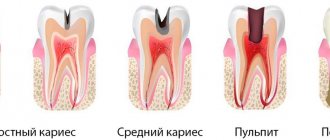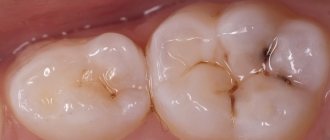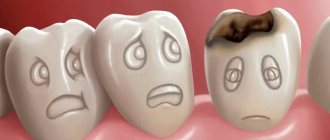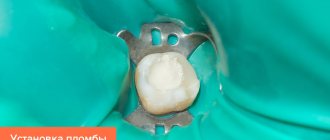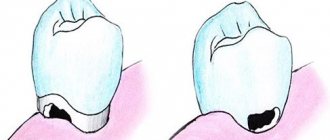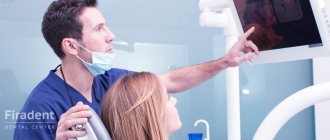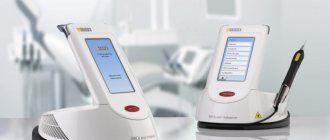The treatment tactics for caries depend on the cause of the pathological process and its neglect. This is the most common dental disease, characterized by gradual tooth decay. The pathology goes through several successive stages; at first, the patient may not feel anything; in complex cases, complete loss of dental units is possible.
It is not difficult to detect the disease, because most of the symptoms are quite obvious. However, it is better to prevent the occurrence of carious lesions by following preventive recommendations, and then a snow-white smile will delight you for many years.
Caries - what is it?
More than 95% of the inhabitants of our planet face the disease. Thus, it can be called the most common dental problem. At the very beginning, the pathological process affects only the enamel, and in the absence of therapy it penetrates into the deep hard layers. Then the soft tissues with nerve fibers and blood vessels become inflamed.
The disease is insidious because in the earliest stages it does not manifest itself in any way, and the patient begins to sound the alarm only when acute pain and a large hole appear that cannot be eliminated by conservative methods.
How to treat dental caries in adults?
Caries is treated in two main ways - invasive and non-invasive. The first option involves preparing a carious cavity by drilling with dental burs. The second option is more gentle and does not involve the penetration of instruments into the tooth. In essence, this is an option without drilling teeth.
It is impossible to say that one of these methods is better and the other worse, because they solve different problems. Non-invasive methods for treating caries in adults help only if the damage is minor and the disease is in an early stage. Much more often, patients turn to the dentist with moderate caries (sometimes deep), when it is impossible to properly cure the tooth without invasive intervention.
Causes of caries development
Oral disease develops under the influence of pathogenic microorganisms that multiply in a favorable environment. Dentists are of the opinion that the disease occurs due to changes in the acid-base balance on tooth surfaces. Fermentation of carbohydrates caused by pathogenic bacteria releases destructive amounts of organic acids.
The main factors that contribute to the formation of carious cavities:
- improper hygiene care;
- eating problems;
- systemic chronic or acute diseases of the gastrointestinal tract;
- reduced concentration of vitamins and minerals in the body;
- hereditary predisposition, etc.
Bacterial plaque and tartar
Streptococci are microorganisms that live in organic acids, leading to the destruction of enamel and dentin. During brushing, soft structures are easily removed, but hardened structures cannot be removed. They also contain pathogens that cause destructive phenomena.
Poor nutrition
Every person knows from an early age that you can’t eat a lot of sweets. However, adults often ignore this rule and consume large amounts of carbohydrates, sugar, baked goods, and starchy foods. The enamel layer becomes thinner and more susceptible to external factors. Bacteria multiply better in a carbohydrate environment.
Decreased salivation
During the day, a person secretes about 2 liters of saliva. The secretion washes away food debris from dental surfaces and protects them from the negative effects of pathogenic microflora. If the salivary glands do not function well enough, a lot of food particles settle on the crowns, which the microbes feed on.
Violation of the mineral composition of enamel
This factor is directly related to diet. Demineralization is observed with a meager, monotonous menu, lack of calcium, phosphorus and fluorine. Seeds, cottage cheese, cheese, red beans, and buckwheat are rich in such microelements.
Genetic predisposition also influences mineralization. This means that the disease can be inherited from parents and other relatives.
The problem occurs in pregnant women at different gestational stages. The fetus takes all the useful minerals, and the expectant mother experiences a lack of them. Subsequent intervention is complicated by the inability to use anesthesia.
How is caries treated without drilling?
Many adults are even more afraid of dentists than children, and prefer to treat dental caries using non-invasive methods, without the use of dental burs. Conservative treatment without drilling teeth can be carried out using several methods.
The first option is remineralization. When caries just begins to affect the tooth enamel, a small white spot forms on it. This is the focus of demineralization - the zone in which the loss of mineral components of the enamel began. If you notice a change in enamel color in time and contact your dentist, your doctor may prescribe remineralization therapy to restore mineral balance. The dentist treats the patient’s teeth with special fluoride and calcium-containing preparations, makes medicinal applications, or prescribes home use of medications with a similar effect. Deep fluoridation is considered the most effective method of remineralization therapy.
How is caries treated using the ICON method?
When dental caries in adults is in the staining stage, it can be treated with a non-invasive infiltration method. This technology allows you to stop the spread of carious lesions deep into the tooth without the use of a drill.
Caries is treated according to the following scheme:
- The dentist removes plaque and other deposits from the surface of the tooth enamel.
- A special etching gel with hydrochloric acid is applied to the affected area.
- Within two minutes the surface layer is removed;
- After two minutes, the gel is washed off with an air-water jet, the surface is dried and washed with an ethanol solution to remove residual moisture from the porous areas of the tooth. At the final stage, the tooth is covered with a composite material that seals the pores of the tooth enamel.
The main advantages of the method: it is possible to treat both caries of permanent teeth and baby teeth for children.
The treatment is absolutely painless, so no anesthesia is needed. Healthy areas of dental tissue are preserved during treatment. You can quickly and easily treat carious lesions on several teeth in one visit. The procedure takes no more than 15 minutes.
How to treat caries step by step
The algorithm is something like this:
- Plaque and dental deposits are removed from the surface of the diseased tooth and those adjacent to it. For this purpose, abrasive pastes, ultrasonic nozzles, and special brushes are used.
- The dentist selects a shade of filling material that is as close as possible to the natural color of the teeth. A special scale is used to select the tone.
- Anesthesia. Treating medium and deep caries without anesthesia is quite painful, so most patients are given local anesthesia - an anesthetic injection. The duration of its effect depends on the type and dosage of anesthesia.
- Preparation of a carious cavity. At this stage, the doctor drills out the affected tooth tissue, removing destroyed dentin and the edges of the enamel hanging over the cavity. If the dentist violates the technology and leaves at least part of the affected tissue under the filling, the patient will develop secondary caries, and if the crown is completely destroyed, pulpitis and periodontitis.
- Isolation of a diseased tooth. To properly fill a tooth, it must be dry. Therefore, dentists use a rubber dam (a special plate) to protect the tooth from saliva. The quality of insulation directly affects the service life of the seal.
- Treatment of the tooth cavity with antiseptics for thorough disinfection.
- Reconstruction of the side wall. If the carious lesion is located in the area between the teeth, the tooth wall must be restored before installing a filling.
- Acid etching and adhesive application. These manipulations are necessary in order to increase the adhesion of the cavity walls and the filling material and ensure reliable fixation of the filling.
- Installation of therapeutic or insulating pads. Therapeutic ones are given in the presence of inflammation; insulating ones are needed to prevent shrinkage of the filling and its negative effect on the tooth tissue.
- Filling. Today, photopolymer composites are used in most cases. They are applied layer by layer and illuminated with a lamp to harden the material. Photopolymer composites are good because they almost do not shrink, have high strength and reliability.
- Bite adjustment, grinding and polishing. The doctor adjusts the size and shape of the filling so that when it comes into contact with the teeth of the opposite row, the filling does not interfere, and the jaws can close normally. At the end of the procedure, the dentist grinds and polishes the surface, removing all unevenness and roughness and giving the filling an aesthetic appearance.
Thus, caries in adults can be treated in different ways. The choice of method depends on the stage of the disease, tolerance to anesthesia and a number of other factors. It is important to remember that the sooner you see a doctor, the simpler and faster the treatment will be.
Root caries
Root caries
develops deep under the gum, violating the integrity of the tissues, while during visual inspection it may not be noticeable.
The basal species is localized on exposed roots and is characterized by a rapid course of the process. The enamel in the root zone has a minimum thickness, so it is quickly destroyed under the influence of external factors. How to treat root caries
is an important question that only a dentist can answer after an initial examination and a comprehensive diagnosis.
Folk remedies in the fight against dental disease
Want to know how to cure tooth decay at home without a dentist? To help yourself maintain the health and integrity of the dental structure, you should remember how and how caries is treated. You can influence the condition of your teeth and overall well-being by adjusting your diet and taking more careful oral care. By reducing the consumption of sweets and soda, unhealthy foods and fast food, while adding fresh vegetables and fruits to the menu, you can prevent the occurrence and development of the disease.
Various folk remedies used in oral care will help improve the general condition of teeth and strengthen their structure. You can use decoctions of sage, calamus and other herbs for rinsing. In addition, you should rinse your mouth and try to brush your teeth after every meal. In daily hygiene care it is necessary to use special dental floss. It will help remove food debris from the interdental spaces, stopping the proliferation of pathogenic bacteria. You can do all of these preventive procedures at home yourself.
Indications and contraindications
Indications for treatment of the disease are both visual and tactile; these include:
- color change, enamel pigmentation;
- painful reaction to hot or cold, sweet or salty;
- enamel chipping;
- darkening of the cervical segment;
- carious cavity;
- a dark gap located along the border of the filling.
There are also contraindications to caries treatment:
- acute respiratory diseases;
- first and third trimesters of pregnancy;
- acute stage of periodontal disease, which is accompanied by severe bleeding of the gums;
- herpes in the acute stage.
Preventive measures for cervical caries
It is important for patients to remember that this type of pathology develops very quickly, so if even minimal changes are detected in the cervical area, they should seek dental help as soon as possible. Modern techniques make it possible to completely restore the appearance and functionality of the affected tooth with uncomplicated caries. Treatment is cheaper, faster and easier for the patient, and the risk of complications is reduced to zero.
As for preventive measures, they consist of ensuring effective and regular hygiene measures for the oral cavity using individually selected toothpaste, brushes, floss and rinse. In addition, you should regularly visit the dentist for preventive examinations and professional oral hygiene, to prevent the development of gum diseases.
Professional treatment of cervical caries in CELT allows you to preserve the functionality and aesthetics of the dental unit. You can make an appointment with our specialists online or by phone: +7 (495) 788‑33‑88.
Make an appointment through the application or by calling +7 +7 We work every day:
- Monday—Friday: 8.00—20.00
- Saturday: 8.00–18.00
- Sunday is a day off
The nearest metro and MCC stations to the clinic:
- Highway of Enthusiasts or Perovo
- Partisan
- Enthusiast Highway
Driving directions
